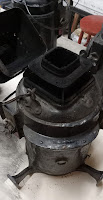Since we're going to be having operations after dark on both Labor Day and Member's Day weekends, it's time for another exciting aspect of historical accuracy: oil-fired lanterns and marker lights!
Railroading started, of course, long before the invention of the electric light bulb, and oil lamps continued to be used for hand lanterns, switch stands, signals, and so on for many years afterwards because they were much more reliable. It's impossible to predict when a battery is going to die or a light bulb will burn out. But as long as you have an easily-checked supply of fuel, wicks, and matches, you can keep an oil lamp burning forever. With modern technology, of course, electric lights are so reliable that no one on the railroads would think of going back to the hassle of maintaining oil lamps -- except us.
Luckily we have a good supply of authentic marker lights for use on our interurban cars, as seen here. These are Adlake marker lamps designed to fit the brackets installed at each end of the cars. (I also have an IC hand lantern that belonged to my uncle's father-in-law.) Each marker has two Fresnel lenses, and each lens has two movable color filters, red and green. Thus each light can show either white, red, or green. Some of the mechanisms for moving the filters are jammed, however, but I have it arranged so each lamp shows red on one side and white on the other. That's all we'll need for our operation.
 |
| Color filter control |
 |
| The top is hinged. The chimney is in two parts, easily removable. |



4 comments:
Randall,
The only other place i know of that uses oil lamps for their night operations is the WW&F Railway Museum at Alna, Maine. Those two-foot guys really think it is still 1910!
Ted Miles, still an IRM member.
To put this in context, when I went to work for the CTA in 1975 they were still using red and green oil lamps to mark slow zones. When the station at O'Hare was opened in 1984 the Facilities Maintenance carpenters were given a room behind the Transportation office for a tool lock-up. The drawing of the station labeled this the "lamp room", although it was never used as such, the CTA having adopted yellow battery powered flashers for temporary slow zones a couple years earlier.
When I was conductor on the CA&E cars on Sunday night, there was only one pair of lamps, so I removed them and carried them through the train each time we reversed ends. Combine that with trying to put up a trolley pole in the dark, and it was an interesting evening.
Sorry about that! Since those were the steel cars, that's a department responsibility, but if we're going to have more night operations we need to have a regular system to take care of it. And putting a pole on the wire in the dark is always a challenge. I hope you had a good time nonetheless.
Post a Comment